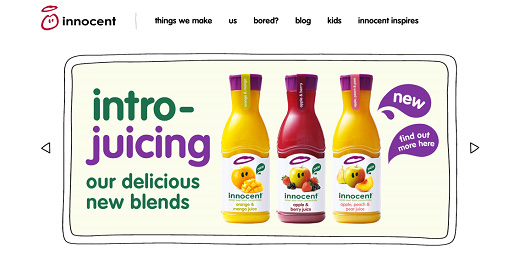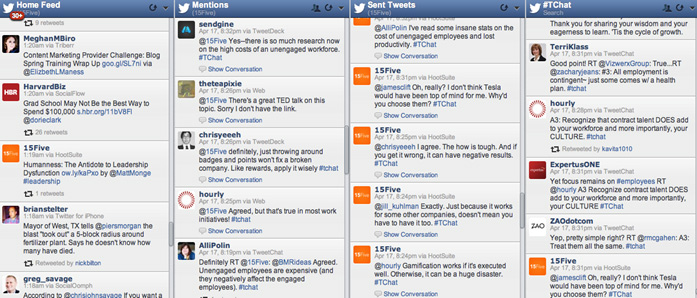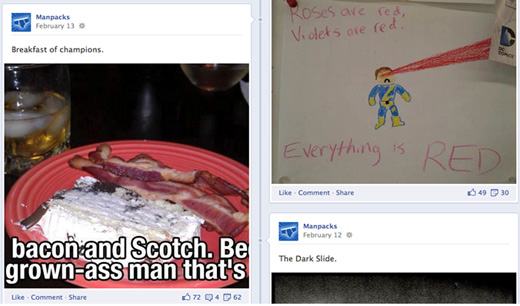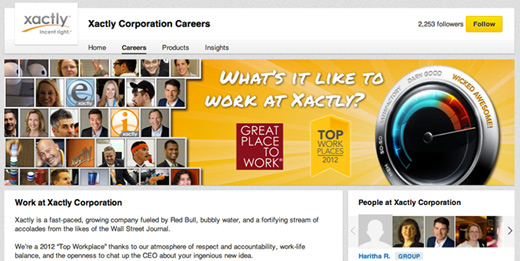We live our lives in social media. When you go on vacation, all 1,049 of your Facebook friends will see the pictures of you lounging on the beach. When you’re stuck in traffic on a Monday morning and need to vent, your Twitter followers are there for you! In fact, there are 3.2 billion interactions on Facebook and over half a billion tweets published every single day.
It only makes sense that marketers have spent the last few years trying to figure out how to monetize social media. How do you turn social media into a real customer acquisition channel?
In trying to answer that question, the concept of social customer acquisition was born. What is that? Social customer acquisition is essentially the art of building and maintaining relationships to improve the traditional customer acquisition and retention processes. It’s not restricted to social media, but social media is certainly a good place to start.
Non-social customer acquisition tactics are on their way out. Traditional push marketing just can’t keep up with pull marketing. 70% of consumers trust brand recommendations from friends and family, but only 32% trust information on brand websites (and even fewer trust ads). While most startups are aligned with the inbound, social customer acquisition movement, many of them are still struggling to do it effectively.
Two companies that are doing social customer acquisition well are Habbo Hotel and Innocent Drinks, but they’re both doing it in very different ways. There’s more than one way to make friends, cultivate advocates and convert those relationships into sales.
Habbo Hotel is a massive multiplayer online community. Essentially, you create a digital version of yourself, build virtual rooms to hangout in and make new friends. The sense of community Habbo Hotel has created inspires teens and young adults around the world to pay for virtual products. Trade in your real world dollars for online currency to build the best room, “wear” the best clothes, etc. Cash for pixels.
Innocent Drinks is a fruit juice and smoothie brand from London. You can find them on almost every major social media platform: Facebook, Twitter, YouTube, Flickr, Instagram, Pinterest – you name it. But social customer acquisition isn’t about being on every platform possible, it’s about choosing the right platform(s) for your demographic and building a strong community.
What makes Innocent Drinks great is that they have built, and are always maintaining, active communities on all of their branded social media platforms. The entire company is fun and social… they’ve made juice exciting and, more importantly, interactive.
Habbo Hotel reported $78.7 million in revenue in 2010. Innocent Drinks brings in an impressive $306 million in revenue. These brands rely heavily on their communities to get the word out. Habbo Hotel users tell their friends at school, they make new friends online, they buy virtual items and they fuel Habbo Hotel’s partner advertising program. Innocent Drinks’ communities are also incredibly engaged. They’re tweeting about Innocent to friends, they’re submitting videos for YouTube contests, etc.
Unless you own a very specific type of brand (like Habbo Hotel), popular social media platforms will likely be the best social customer acquisition channels for you. So, here’s how you can skip the vanity metrics and start monetizing your social media communities.
Social Media
Think of social media as the modern form of “word of mouth marketing”. People are talking about your brand on social media, whether you’re listening and engaging or not. But, it’s important to note, your customers really do want you to be listening. Nearly half of customers expect customer service via Facebook alone, but only 23% of brands provide it. The cost of not being involved with social media is rising every single day.
There is literally an endless list of social media platforms online. For that reason, let’s focus on three of the most popular platforms: Twitter, Facebook, and LinkedIn.
1. Twitter
Twitter is one of the best social media platforms for engagement and community building. Two strategies you’ll want to use are: attending Twitter chats and building influencer lists.
One of the easiest ways to start building a community from the ground up is to insert yourself into relevant existing communities. 15Five, an employee feedback system, is a perfect example. They write about leadership, company culture and team productivity on their blog. They attend #TChat, a weekly Twitter chat hosted by the people behind the popular talent management blog, Talent Culture.
Twitter chats are a great way to connect with a lot of people who you know are interested (or could be interested) in your product at once. The more often you attend the same chats, the more recognition you’ll receive. You can also use Twitter chats to tastefully promote blog posts you’ve written that are relevant to the topic every once in a while.
Eventually, the relationships you build in the Twitter chat communities will extend beyond that hour a week. They make a great foundation for your own community!
Tip: Here is a big list of some of the most popular Twitter chats.
Another concept we should all be familiar with is: influence the influencer. You can always create search streams in HootSuite to monitor your keywords and engage with the people talking about them. But, unfortunately, you’ll be sifting through a lot of irrelevant tweets.
Speed up the process a bit by going straight to the top. Identify influencers in your industry and add them to private Twitter lists. Set those lists up as streams in HootSuite and then reach out to 2-3 influencers per list every day. Your influencer outreach tweets don’t need to be relevant to your brand (but it’s great if they are). Remember, this is a marathon – not a sprint.
To bring it all full circle, be sure you’re tweeting links to your website. That will help you push traffic and avoid the vanity metrics commonly associated with social media. The best way to tweet links to your website without seeming spammy is to have a blog. That way, you can provide real value to your community while driving traffic to your website. It’s win-win!
Tip: Use a link shortener like ow.ly or bit.ly to monitor clicks and see what works best. What tweets get the most retweets? Favorites? Replies? Measure and optimize your tweets going forward.
Statistics
- There are 460K accounts created every day.
- 32% of all Internet users are using Twitter.
- 56% of customer tweets to companies are being ignored.
- 69% of follows on Twitter are suggested by friends.
- 77% of the top 100 companies have a Twitter account.
- 34% of marketers have generated leads using Twitter.
2. Facebook
Facebook is the platform your customers really, really want to see you on. They want customer service via Facebook and they want you to be available to engage with them via Facebook. The two biggest values you can offer on Facebook are: entertainment and support.
Facebook is full of funny and inspiring content. Providing entertainment value by posting funny pictures that are relevant to your brand is a no-brainer. Manpacks, a subscription service for men (which shut down in 2018), is a great example. They often post funny pictures they know men will love. At Onboardly, we post a lot of inspiring image quotes that are relevant to entrepreneurs.
As a general rule, if you can make someone laugh or inspire someone, you can start building a relationship with them. Facebook makes it easy to do either, especially since it’s image-heavy.
You’ve probably heard that a bad customer experience travels fast. If a customer goes home dissatisfied, you better believe they’ll tell anyone who will listen. Fortunately, a good customer experience travels fast too. Customers want support via Facebook, so offer it!
On your contact page on your website, give an email or contact form, but then link to your Facebook page. Note that you answer questions via Facebook as well. Often, your customers will choose social media over email. Why? Because it’s instant. The more people see you responding to support issues via Facebook, the more people will turn to it.
The inspiring and funny content you’re posting is designed to bring in likes and shares. The more likes and shares you receive, the greater your Facebook reach. And the greater your Facebook reach, the more fans you’ll see. Of course, that just means more relationships to build and more potential customers to initiate into the community.
Plus, as your current customers are telling their friends about the great customer experiences they’ve had via Facebook, you’re gaining word of mouth momentum!
To bring everything full circle, be sure your website URL is visible in your bio beneath your profile picture and post your blog content to your Facebook page. Again, the idea is to funnel the community you’ve built on Facebook to your website in order to make the conversion.
Statistics
- Monthly active users now total almost 850 million.
- 23% of Facebook’s users check their accounts 5 times or more per day.
- 80% of social media users prefer to connect with brands through Facebook.
- 77% of B2C companies have acquired customers from Facebook.
- 43% of B2B companies have acquired customers from Facebook.
3. LinkedIn
LinkedIn has two major differentiating factors: B2B and trustworthiness. While Twitter and Facebook are more universal, LinkedIn is very focused on B2B connections and leads. LinkedIn users also have a surprising amount of trust in the information they read on the social platform.
The three most popular ways to connect via LinkedIn are: individual influencer outreach, a branded page, and a group.
It might seem obvious, but extending your personal network by getting warm introductions to influencers is very powerful. While most people use LinkedIn to connect with current and previous co-workers and employers, you can use it to connect with industry influencers, whose opinions have a big impact on your customers.
You can also create a branded page on LinkedIn, which is a little less personal and, arguably, less effective than individual influencer outreach. A LinkedIn branded page is a good way to keep those interested in your brand up to date, but it doesn’t leave much room for engagement or relationship building. Still, some brands (like Xactly, a sales compensation management platform) have managed to keep their pages interesting.
In addition to brand pages, many people decide to join or create groups. Think of LinkedIn groups the way you thought of Twitter chats. It’s easier to insert yourself into an existing community than it is to build a new community from the ground up. Identify a list of groups that are relevant to your industry. Where do your industry influencers chat? Where do your customers chat? Join those groups and start engaging.
Just like with Twitter chats, eventually, you’ll be able to extend those relationships beyond the LinkedIn group. It’s the first step towards creating your own community on LinkedIn.
One of the best ways to funnel your LinkedIn community to your website is, you guessed it, via blog content. Post your blog content to your personal page, sync your RSS feed with your branded page, join discussions relevant to your latest blog post, etc. Otherwise, just make sure you have added all of the necessary links to your profiles, pages and groups.
Tip: When it makes sense, try to move conversations to email. B2B leads check their email more often than their social media, unlike most B2C leads. You’ll see quicker responses. LinkedIn is a great platform for initial connections, but relationship building can be slower there than on other platforms.
Statistics
- In January 2013, LinkedIn surpassed the 200 million user mark.
- 87% of users trust LinkedIn as a source of information affecting decision making.
- 49% of users think LinkedIn is a good source of word of mouth information on brand experiences.
- 50% of users build new networking relationships with individuals who may influence customers.
Measuring Results
1. Avoid Success Theater
With social customer acquisition, you run the serious risk of winding up in what Eric Ries calls “Success Theater”. Oh, wow, Twitter followers increased by 10%? That’s awesome. And your latest Facebook post was shared 100+ times? Cool. But… so what? What do Twitter followers and Facebook shares have to do with, well, anything? It’s social customer acquisition.
When we’re dealing with something as intangible as relationships, we tend to start to look for “easy metrics”. We want to assign numbers to our efforts and those vanity metrics are just sitting there, shiny and ready to impress.
The truth is, you should be more interested in a small, highly engaged community than a large follower or fan count. If there’s no relationship there, a follower is just a number.
So, while it might be tempting to measure your progress based on easy, vanity metrics, you have to resist. Don’t trick yourself into thinking you’re progressing and seeing growth when all you’re really seeing is 100 new bots per week.
2. Identifying Key Metrics
Vanity metrics, although great to look at, don’t do anything to move the needle. This has been a huge problem for social media marketers in the past and that same problem has been affecting social customer acquisition. How the heck do you put a price on a relationship? How do you measure the growth of a friendship? Is there a social media ROI?
The process still isn’t cut and dry. You will see value that you can’t accurately measure, but that doesn’t mean you shouldn’t be measuring anything at all.
Start by identifying your key metrics and then work backwards. For example, let’s say you work on a freemium model like 15Five. One of your key metrics might be the number of free trial signups you receive. So, you’ll want to push as much qualified traffic to the landing page as you can. A reasonable key metric for social customer acquisition would be unique social referral traffic.
Are you measuring all of the relationships you’re building? No. Are you measuring all of the intangibles that come along with social customer acquisition? No. But you are tying your efforts to a goal that has real world value.
Because, let’s face it, all of those relationships are worthless without the conversion. It’s like collecting emails for a mailing list and then never sending anything out. What a waste!
So, you’ve decided to measure unique social referral traffic. Consider going a step further and measuring social goal completions as well. That way, you’re measuring the amount of social traffic and then the number of goals that that traffic completes. Think of it as almost a separate funnel.
3. Tools
Two of the best tools for measuring your results is Google Analytics.
You can always use Google Analytics’ advanced segmenting to monitor your social traffic. Create segments for your major social channels. Twitter, Facebook, your blog – whatever.
Here’s how…
- In Standard Reporting, click “Advanced Segments” in the top left-hand corner. Click “+ New Custom Segment.”
- Name the segment and then choose your parameters. There’s a lot you can do with advanced segments.
- Make sure “Include” is selected and then search for “Source” in the green field.
- Make sure “Containing” is selected as well.
- Then enter the source you’d like to attribute traffic and events to. For example, “twitter.com”. For best results, consider what other names the sources might send traffic from. For example, for Twitter, “t.co” and “hootsuite.com” and “ow.ly”.
- Add as many variants as you’d like using the “Add ‘OR’ statement” button.
Your advanced segments will allow you to look at all of your Google Analytics data with a focus on just the social elements.
Best Practices
1. Create customer-driven content calendars.
A big part of social customer acquisition is content creation. When they hear the term “content creation”, most people immediately think of blog posts. While blog posts are certainly part of it, there’s much more to it than that.
What you publish via social media, what press releases you push, what eBooks and webinars you develop, etc. all fall under the umbrella of content creation. If you’re doing social customer acquisition right, you’re developing and distributing a lot of high-quality content to benefit your target audience.
For example, Habbo Hotel hosts in-game events and Innocent Drinks creates content for at least six social media platforms daily. But that’s just the beginning. In order to keep all of your content organized, you need to work with calendars.
That could mean a Google Docs spreadsheet with tabs for social media, PR and content marketing. It could mean a big dry erase calendar hanging on your office wall. It doesn’t matter what your calendar looks like, it just matters that you have one.
Use content calendars to plan your release dates, manage your “authors”, manage your deadlines, assign keywords, monitor promotion strategies – whatever makes sense for you.
At Onboardly, we create Editorial Schedules that show: the progress of blog posts (complete, in progress, not started), the assigned authors, the post descriptions, the keywords for the posts, etc. We also create social media calendars, planning our Facebook content up to three months in advance (with a little wiggle room for timely content, of course).
That bird’s-eye view is important for overall strategy and, well, it just plain helps keep you organized when you’re managing multiple social customer acquisition channels.
2. Provide more value than you take.
Social customer acquisition is based on the idea that your community will provide you with value (read: sales). It’s the idea that building genuine relationships with people will inspire them to support you, buy from you and tell their friends about you. That’s a lot of value to take from your community.
Always be focused on providing more value than you’re taking away. So, if you’re a customer support and engagement software company like Groove, you could create a “customer happiness” blog and give tips for keeping customers happy and engaged. Or you could team up with a partner to host a live Twitter chat where you give out free prizes. Or you could use Facebook to post entertaining (yet relevant) pictures and videos daily (never underestimate the value of entertainment).
The idea is to make sure people are getting more than they’re giving. They should be happy to help you or check out your product. They should feel like they’re reciprocating, not like you are reciprocating. So, long before you ask for something, make sure you’ve given much more away. As the saying goes… build your relationships before you need them.
Just think of Clarity, a marketplace for business advice where experts can sell their advice over the phone. They recently launched a free startup advice guide, featuring insights from 100 entrepreneurs who submitted their best advice (Disclosure: I was included). Clarity literally gave away what they’re selling: great business advice. But they also collected the emails (upon download) of those interested in startup advice.
3. 80% community, 20% sales.
This goes hand-in-hand with the last best practice. You know content marketing is 20% creation and 80% promotion, right? Well, there’s a similar rule to work by: social customer acquisition is 80% community and 20% sales.
As marketers and quick-to-react entrepreneurs, our first instinct is typically to drive the sale. Or the freemium signup. Or the blog subscription. Or the eBook download. Or… or… or…
The trick is to have a little patience (it’s a virtue, after all). Building a community isn’t an overnight process. Would you be able to make a new best friend in a week? Not likely. But you definitely wouldn’t be able to make a new best friend in a week if you were constantly trying to sell him Cutco knives (even if you can offer him a “sweet discount”).
Rushing to the sale does more harm than good. Arguably, it’s better to not be on social channels at all than to be on them and spammy. Remember, people trust their friends and family the most. That goes both ways! If you give a bad impression, it’ll spread just as fast (if not faster) than a good impression.
You’re here to build real relationships, to take an interest in your potential customers. The result will be increased sales, improved retention, free word of mouth marketing, etc. You’re not here to build surface relationships that you can exploit for money down the road. That’s the exact opposite of social customer acquisition.
4. Social customer acquisition isn’t just social media.
As we saw with Habbo Hotel, social customer acquisition isn’t exclusively social media. Social media is simply one of the most popular (and one of the most accessible) ways to build relationships online.
Social customer acquisition encompasses anything that puts an emphasis on building and monetizing relationships. That includes parts of content marketing, parts of PR, live events, etc. The list is literally endless.
Don’t limit yourself unnecessarily! You can insert the “social” aspect into most popular types of inbound customer acquisition tactics. Get creative.
Conclusion
Social media is so much more than just another buzzword. Despite popular C-suite belief, it’s not an immeasurable waste of resources. In fact, as we continue to see the shift from push marketing to pull marketing, companies that hop on the social customer acquisition bandwagon sooner rather than later will have a leg up on the competition.
Relationships are a very important form of currency. It’s how entrepreneurs meet investors, it’s how employees meet potential employers and it’s how a new startup gets on TechCrunch. Why not take advantage of channels that are perfectly positioned to help marketers make those relationships and build those communities?
With the right analytics and social media management tools, you can turn relationships into sales. And, perhaps more importantly, you can turn those sales into happy, lifelong customers. After all, the most valuable customer is the one you don’t lose. Then, of course, there’s the word of mouth factor. Don’t think all of those happy customers will keep it to themselves!
About the Author: Shanelle Mullin is the Director of Marketing at Onboardly, a company focused on helping funded tech startups gain visibility and acquire more customers. They do this through content marketing, startup PR and social media. You can subscribe to their blog here.







Comments (24)